Introduction
Navigating the complexities of autism spectrum disorder (ASD) can be challenging for parents and caregivers. Understanding the DSM-5 criteria is essential for ensuring an accurate diagnosis and accessing the right support. The DSM-5, the cornerstone for diagnosing ASD, outlines specific behaviors and developmental challenges that clinicians use to identify autism, including difficulties in social communication and repetitive behaviors.
This comprehensive evaluation combines parents' insights with professional observations, although debates continue about the need for more objective measurements, such as MRI. Recognizing the importance of early intervention, this article delves into the DSM-5 criteria for ASD, exploring areas like social communication deficits, restricted behaviors, and the severity levels that guide tailored interventions. It also highlights the critical role of early developmental screenings and the evolving nature of autism diagnosis, empowering parents with the knowledge to advocate effectively for their children's well-being.
DSM-5 Criteria Overview
The Diagnostic and Statistical Manual of Mental Disorders, Fifth Edition (DSM-5) is the cornerstone for diagnosing the spectrum condition in many countries, including the United States. This manual provides a standardized set of criteria that clinicians rely on to ensure consistent and accurate diagnoses across diverse populations. The DSM-5 concentrates on particular actions and developmental obstacles that are typical of the condition, such as challenges with social interaction, repetitive actions, and limited interests. This approach aims to provide a comprehensive evaluation by combining parents' or caregivers' accounts of a child's development with professional observations of behavior. The criteria have been subject to debate, particularly regarding the subjectivity involved in observation-based diagnosis. This has led to calls for more objective measurements, such as the use of magnetic resonance imaging (MRI), to enhance the accuracy of diagnoses. Despite these discussions, the DSM-5 continues to be an essential resource for healthcare professionals, aiding in early intervention and suitable care for individuals with developmental disorders.
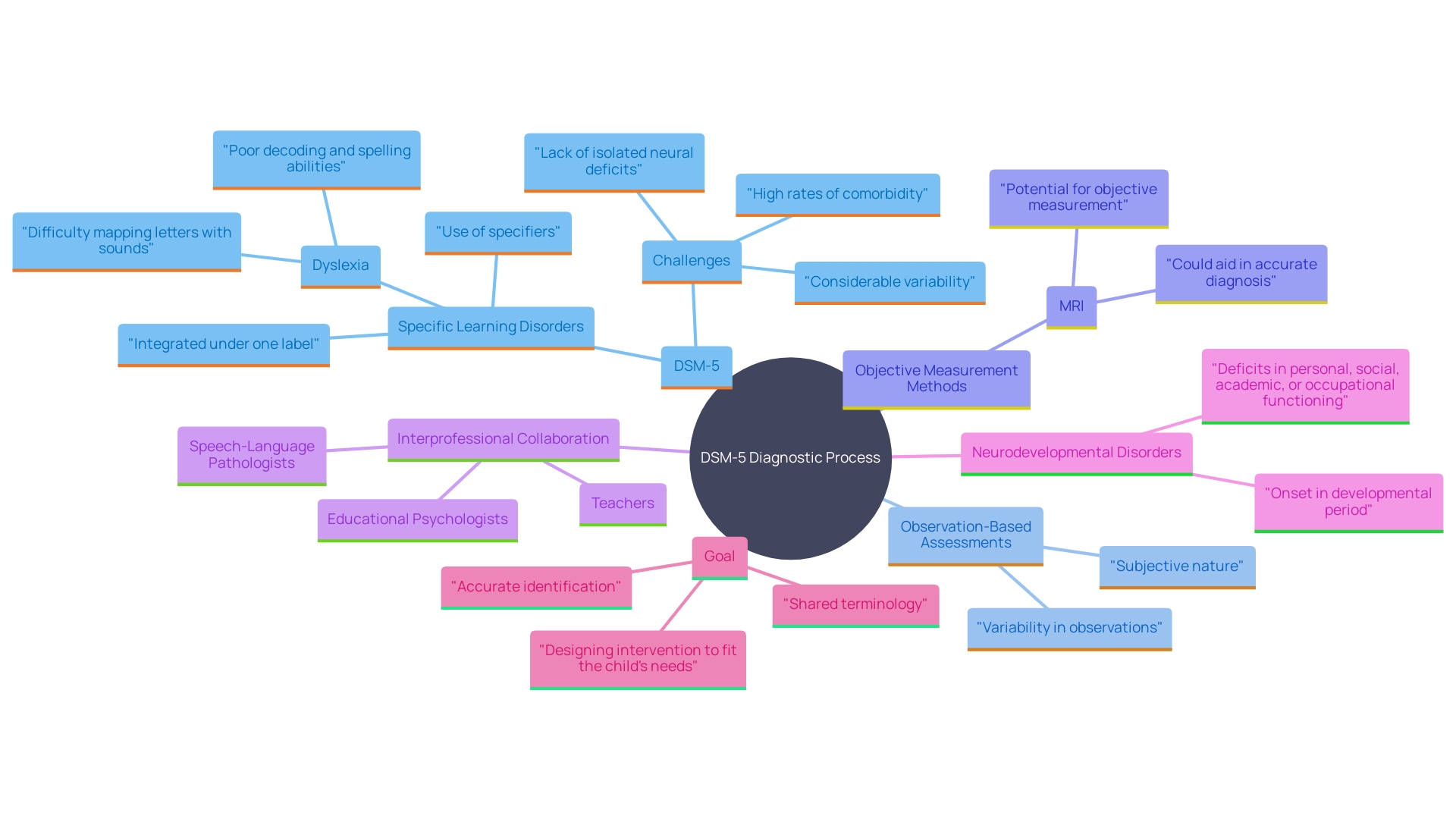
Social Communication and Interaction (Criteria A)
One of the primary areas assessed in diagnosing autism is interpersonal communication and interaction. According to the DSM-5, individuals must display ongoing deficits in communication within various contexts. This can manifest as difficulties in understanding interpersonal cues, challenges in forming relationships, and limited ability to initiate or respond to interactions. Recognizing these patterns is essential for identifying this condition in individuals. An emphasis on interpersonal interaction is essential because it is the fundamental challenge of the condition, as emphasized by Dr. Hannah Schertz’s study on early support. Her work highlights the significance of parental mediation to enhance communication skills in toddlers. This method corresponds with discoveries that developmental interventions greatly improve interactions with caregivers and tackle fundamental issues related to developmental disorders. The Interagency Autism Coordinating Committee’s 2022 Summary of Advances in Autism Research underscores the importance of early screening and diagnosis, which can be facilitated through telehealth and insights into brain differences that affect social communication. By understanding and addressing these deficits early on, we can provide more tailored and effective support for individuals on the spectrum.
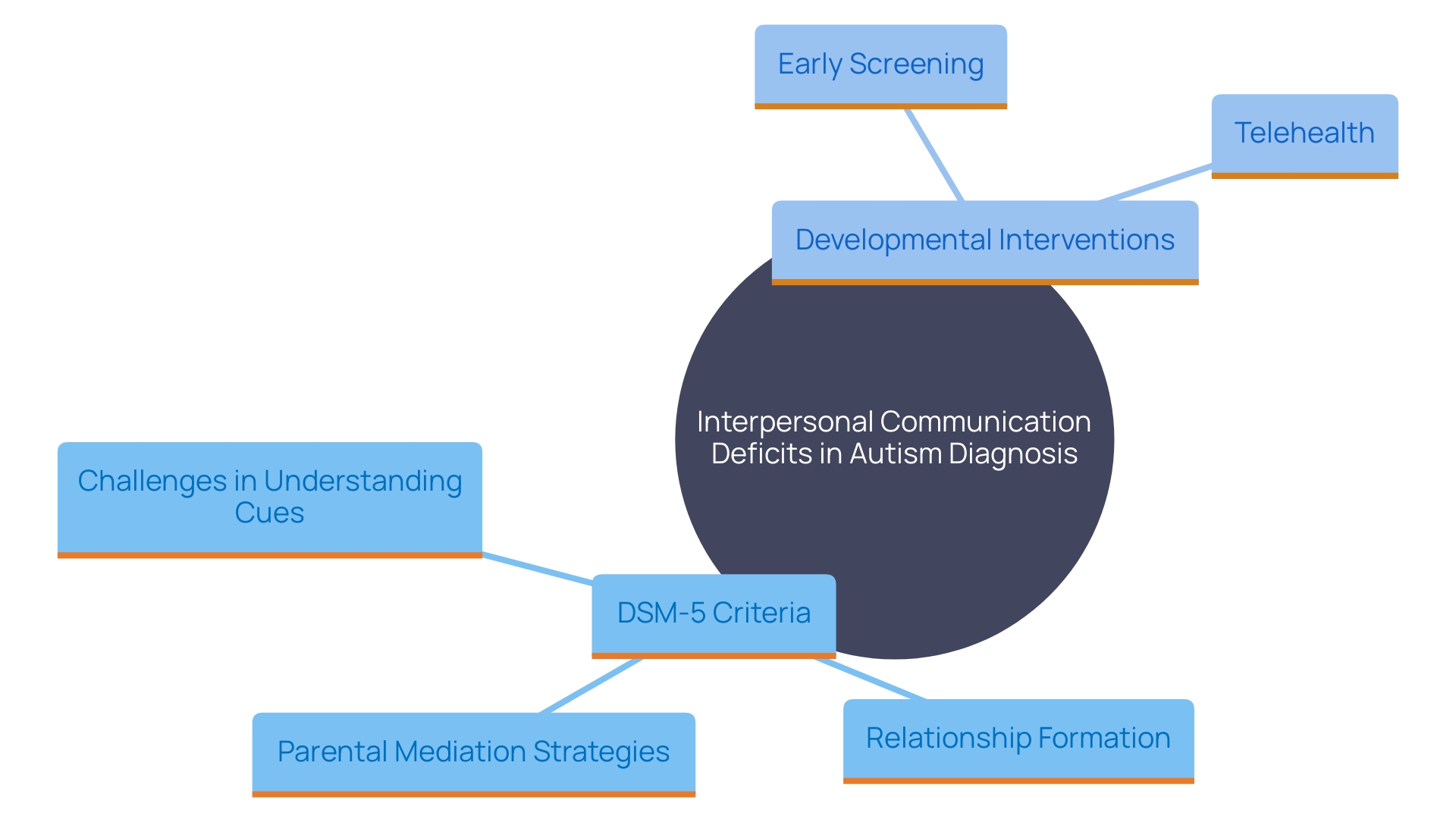
Restricted, Repetitive Patterns of Behavior (Criteria B)
The DSM-5 emphasizes limited and repetitive behavior patterns as essential for diagnosing this condition. These behaviors can include repetitive movements, strict adherence to routines, or intense focus on specific interests. Identifying these behaviors is crucial for caregivers and professionals as it aids them in comprehending how these patterns influence daily activities and interactions with others, ultimately directing effective assistance and support methods.
For example, studies from the University of Geneva (UNIGE) utilized eye-tracking devices to show that individuals with autism frequently concentrate more on non-interpersonal stimuli, such as textures or geometric shapes, instead of interpersonal elements like faces. This finding highlights the significance of customized strategies that address these unique attentional preferences to enhance social communication skills.
Furthermore, early intensive behavioral support, a highly organized method frequently suggested in the United States, offers young autistic individuals individualized assistance for 20-40 hours each week. Despite some clinicians finding it too intense, it remains a predominant method due to its structured nature and targeted skill development. However, there is a growing trend towards more developmentally-informed approaches that are less intense and can be integrated into daily family routines.
Considering these diverse methods, it is essential for professionals to be knowledgeable about the various kinds of strategies and their research foundations to provide the best assistance to youth with developmental disorders and their families. This holistic understanding ensures that measures are not only effective but also aligned with the individual needs of the child, promoting better long-term outcomes.
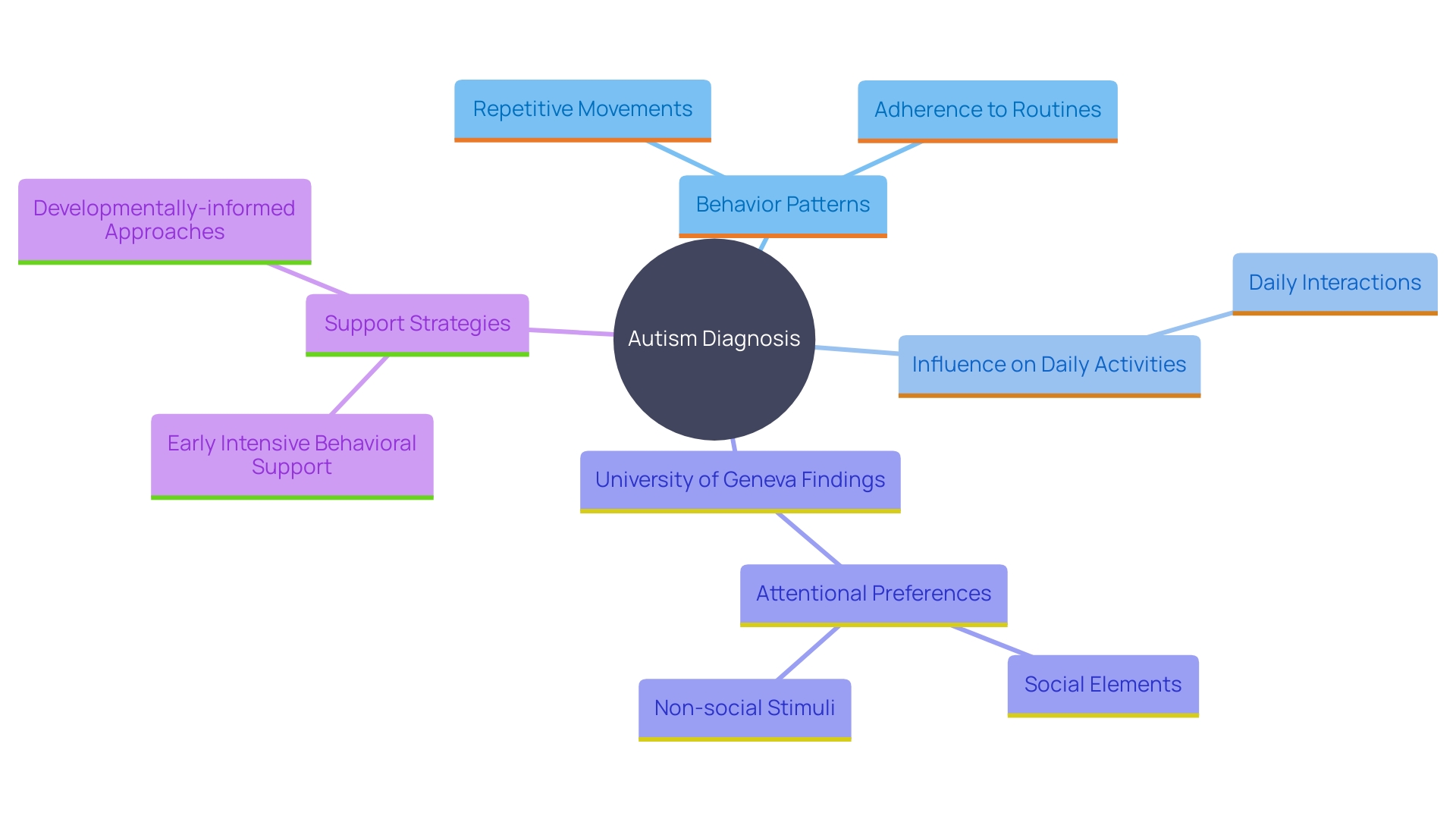
Severity Levels in DSM-5
The DSM-5 criteria for the condition categorize it into three severity levels: Level 1 (requiring support), Level 2 (requiring substantial support), and Level 3 (requiring very substantial support). This classification system acknowledges the various ways this condition presents in individuals and guarantees that support is customized to the particular requirements of each person. Understanding these severity levels is crucial for parents and caregivers, as they help advocate for the appropriate support and resources. According to the Centers for Disease Control, approximately 1 in 68 youngsters in the United States are identified with a developmental disorder. This emphasizes the significance of prompt and tailored support methods to tackle the distinct hurdles encountered by young individuals with developmental disorders. As Michael Sandbank, PhD, highlights, “Pediatricians or therapists need to be more explicit with families regarding what the landscape of evidence entails and also clarify that these interventions may have adverse consequences that we simply don't understand.” By being knowledgeable about the DSM-5 severity levels, parents and caregivers can more effectively navigate the intricate environment of support and ensure their offspring receive the essential care to flourish.
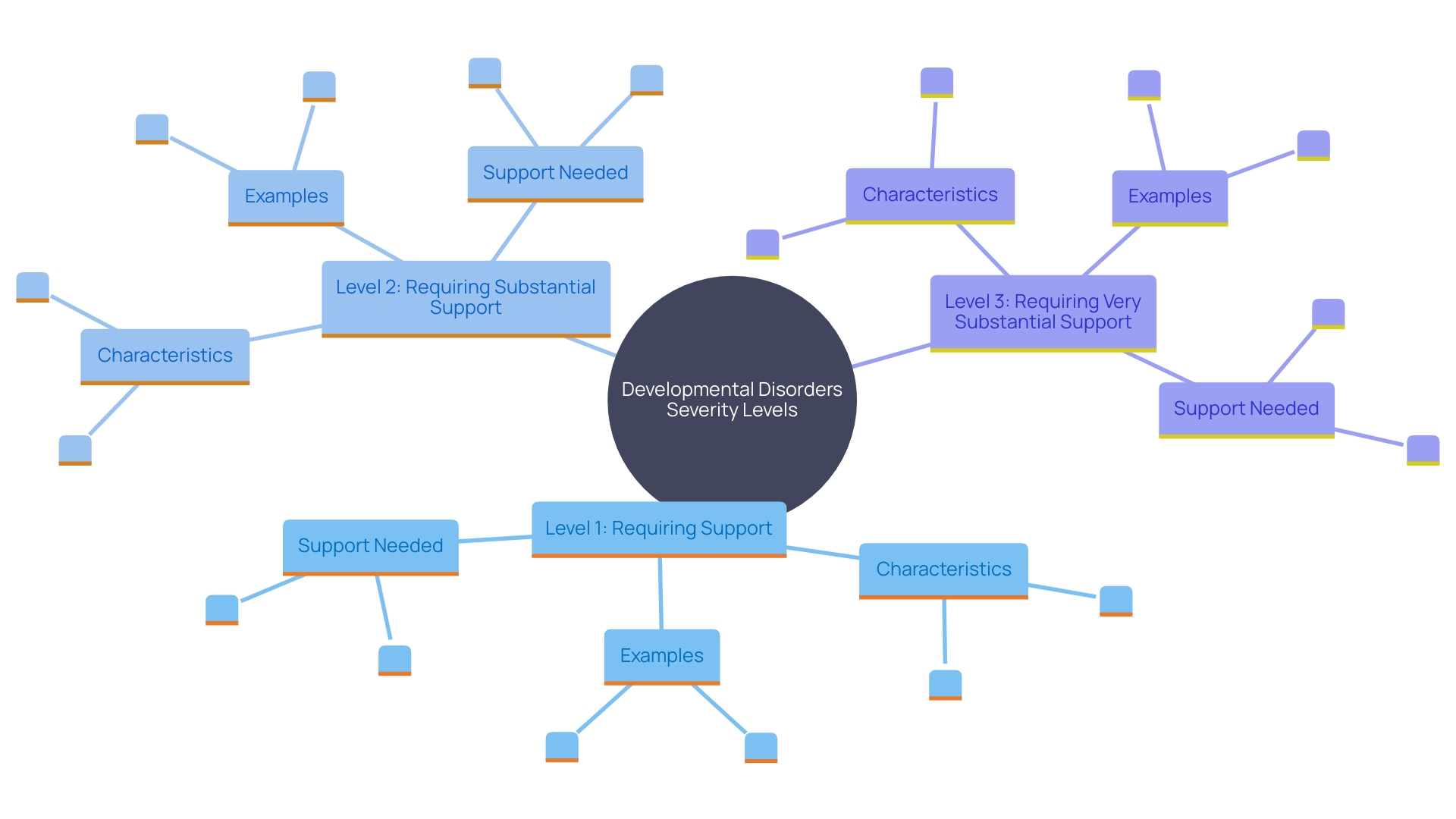
Early Developmental Period and Symptom Manifestation
Indicators of the condition often appear during early childhood, with signs usually becoming more apparent by age three. The DSM-5 criteria emphasize that core features of the condition must be present in early development, although for some children, symptoms may not fully manifest until social demands exceed their coping capacity. It's essential to identify these early indicators to enable prompt action, which can greatly enhance long-term results.
Developmental screenings should be part of regular health visits, with screenings for autism recommended at 18 and 24 months. These screenings are essential as early childhood programs have been shown to promote skill development, particularly in social communication. Pediatricians and other doctors play a key role in guiding families to these methods, which vary in approach and intensity. For example, in the U.S., early intensive behavioral intervention is a common recommendation, requiring 20-40 hours per week, while in England, approaches like pediatric communication therapy and JASPER are supported by evidence.
New research highlights innovative methods for early identification of the condition. For example, AI-assisted examination of retina images demonstrates potential in recognizing the condition and its severity. Ensuring early and accurate diagnosis through professional observation and parental input is essential for effective intervention and support.
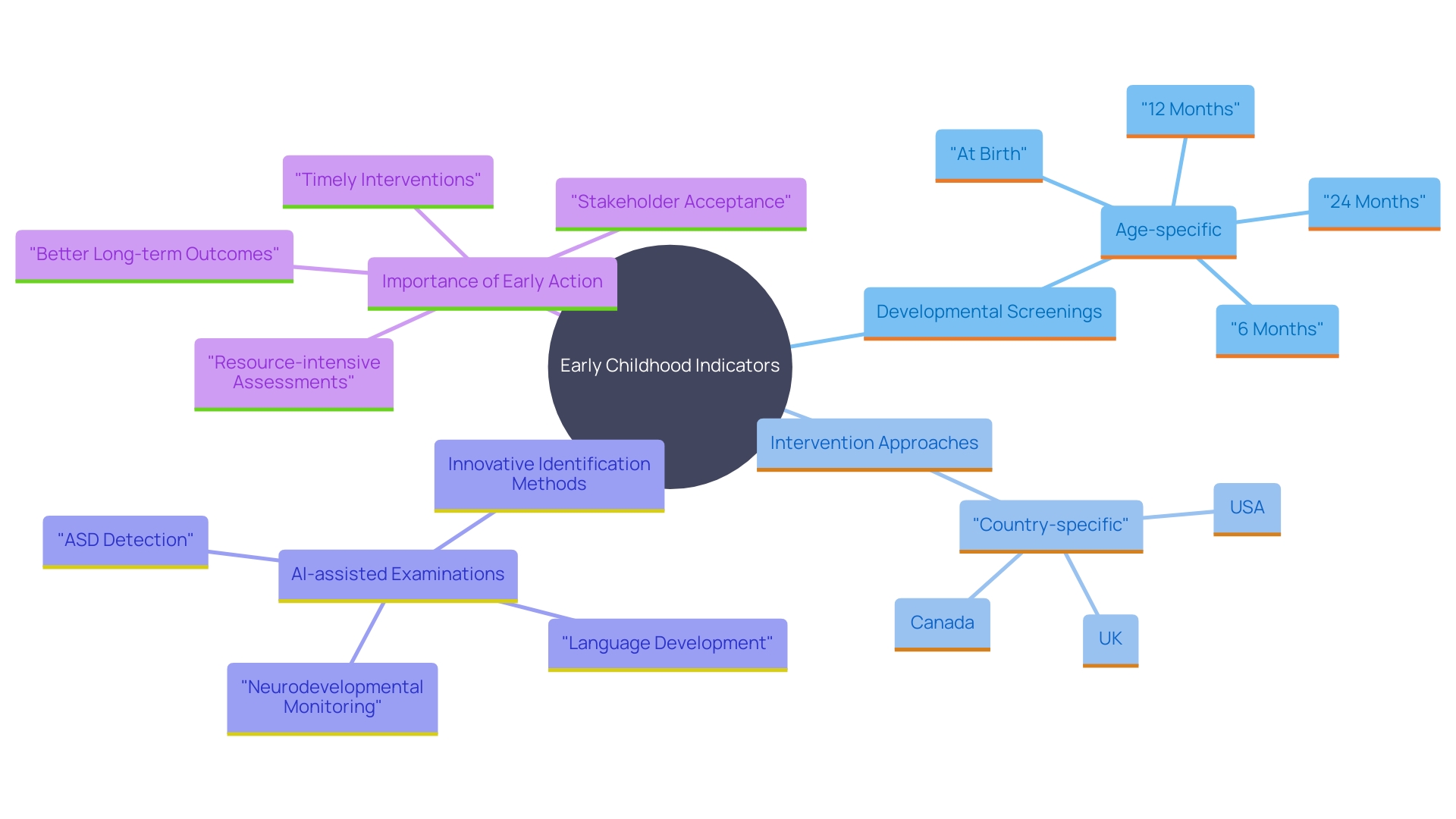
Diagnosis Process and Assessment
Diagnosing autism spectrum disorder (ASD) is a multifaceted process that requires a comprehensive evaluation. It involves clinical interviews, behavioral observations, and standardized tests, all of which are essential in capturing the full picture of a young person's developmental and behavioral patterns. Parents are crucial in this process as their insights and descriptions of their child's development provide invaluable information that professionals use alongside their observations. The DSM-5, a standardized manual by the American Psychiatric Association, outlines specific criteria that must be met for an autism diagnosis. It highlights the existence of essential characteristics such as difficulties in interpersonal communication and limited, repetitive actions from early childhood.
The diagnosis typically involves a team of specialists, which may include neurodevelopmental pediatricians, developmental-behavioral pediatricians, child neurologists, geneticists, and early intervention program professionals. These experts are skilled in assessing communication, behavioral, and developmental levels to ensure an accurate diagnosis. Tools like the Autism Diagnostic Interview-Revised (ADI-R) and Autism Diagnostic Observation Schedule (ADOS-G) are commonly used to evaluate behaviors across social interaction, communication, and repetitive behaviors.
Recent advancements in AI technology, such as the analysis of retinal images, are also showing promise in assisting the diagnosis of this condition and evaluating its severity. Despite these technological strides, the involvement of parents remains irreplaceable. Their active involvement not only helps in achieving a precise diagnosis but also enables them to advocate effectively for their offspring's needs. Prompt action, directed by an accurate assessment, can greatly enhance the quality of life and social adjustment for young individuals on the spectrum.
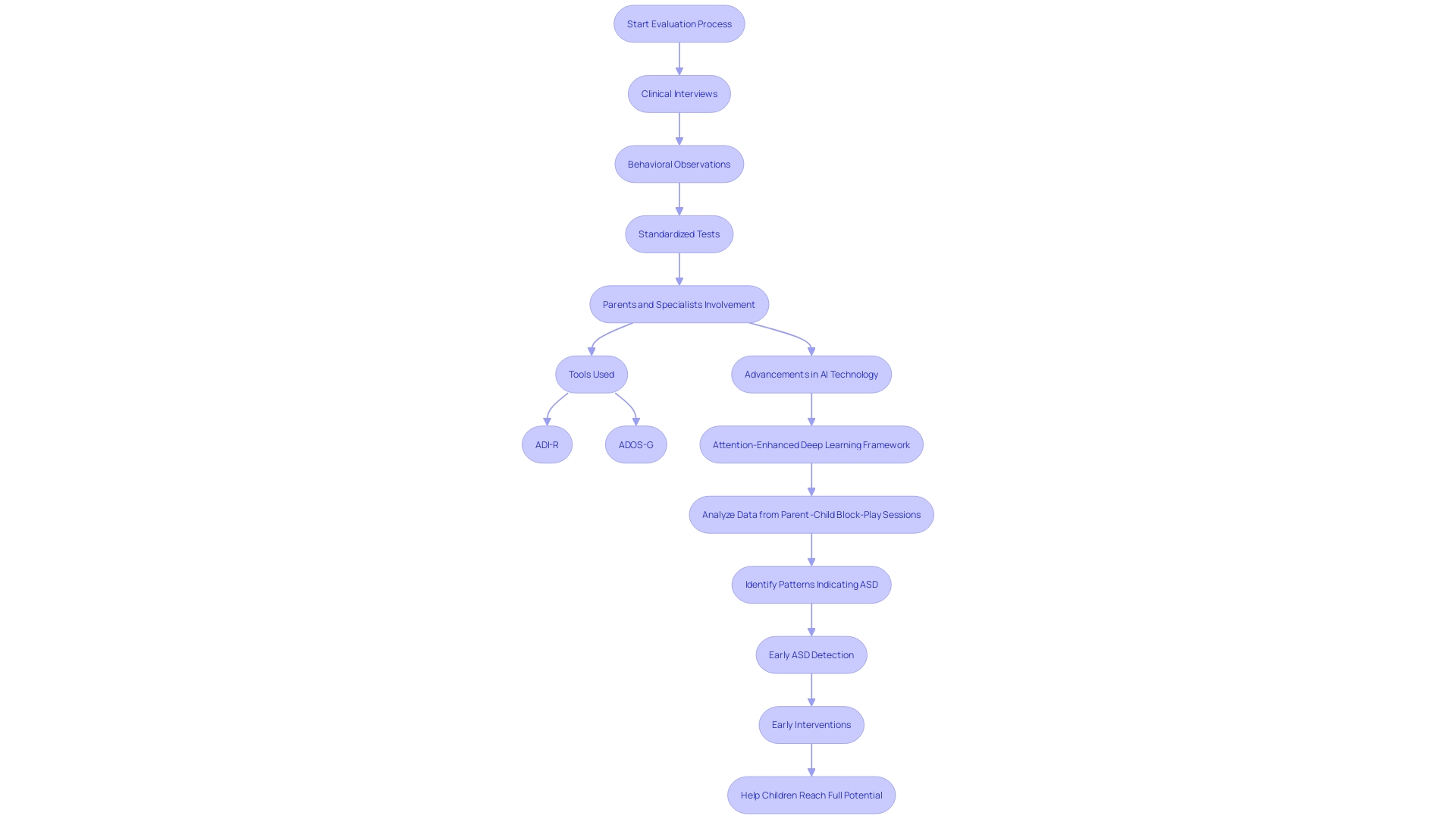
Co-occurring Conditions and Comorbid Diagnoses
Many individuals with developmental disorders also experience co-occurring conditions such as anxiety, ADHD, or sensory processing issues. According to a study led by the University of Glasgow, three-quarters of individuals diagnosed with autism also exhibit traits of other neurodivergent conditions, including ADHD and learning differences. The DSM-5 addresses these comorbidities, emphasizing the importance of considering them in diagnosis and treatment planning. Recognizing these conditions enables parents and professionals to develop a more comprehensive support strategy for the young one. Addressing underlying medical issues can enhance a young person's health, behavior, communication, and social skills. As highlighted by The Autism Community in Action (TACA), many children benefit from a combination of medical treatment and targeted therapy, which can significantly enhance their quality of life.
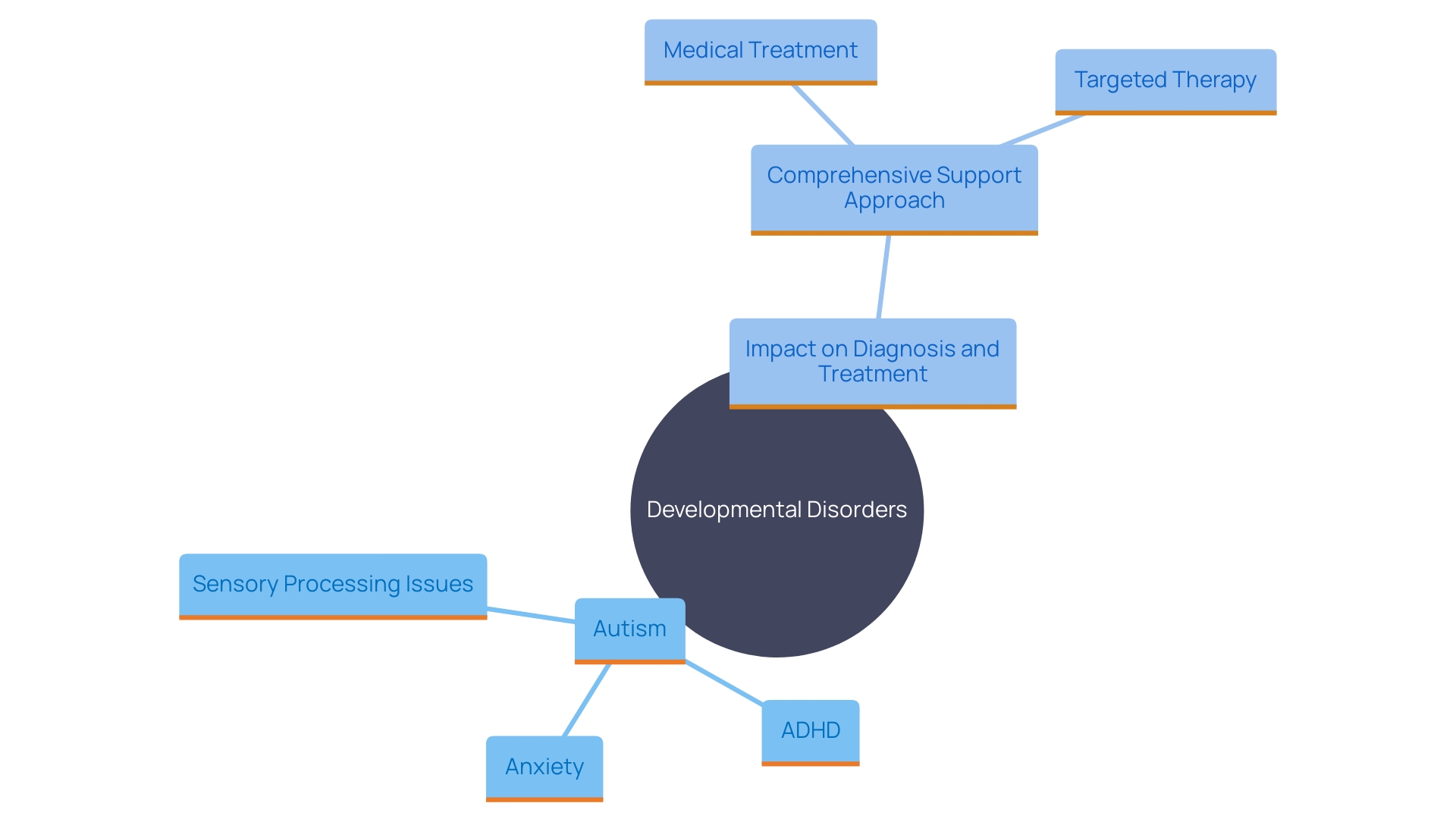
Evolution of Autism Diagnosis and DSM-5 Changes
The comprehension of the condition has evolved significantly since the term was first introduced into the medical lexicon by Eugen Bleuler in 1910. 'Originally used to describe a symptom in schizophrenia patients who appeared self-absorbed and detached from reality, the concept has since been distinguished as a separate condition. Researchers like Leo Kanner and Hans Asperger in the 1940s began to describe behaviors in children that were distinct from those seen in schizophrenia, marking the early recognition of this unique neurodevelopmental disorder.
Today, this developmental disorder is acknowledged as a complex, multifactorial condition with a strong genetic component. The shift from previous editions of the DSM to the DSM-5 demonstrates continuous research and changes in societal viewpoints on the condition. The DSM-5 criteria concentrate on difficulties in interpersonal communication and interaction, along with restricted and repetitive patterns of behavior. These criteria require that the core features of the condition be present in early childhood, although symptoms may not fully manifest until social demands exceed the individual's capacity to cope.
Familiarizing oneself with these changes is crucial for parents. Comprehending the reasoning behind current diagnostic methods, which highlight early detection and support, can assist parents in advocating more effectively for their children. The earlier developmental disorders are diagnosed, the better the outcomes, yet diagnostic delays remain an issue, particularly due to the underdiagnosis and misdiagnosis of females and individuals with more nuanced symptoms. This underscores the importance of awareness and the need for a multidisciplinary approach involving psychologists, neurologists, and psychiatrists to ensure accurate and timely diagnoses.
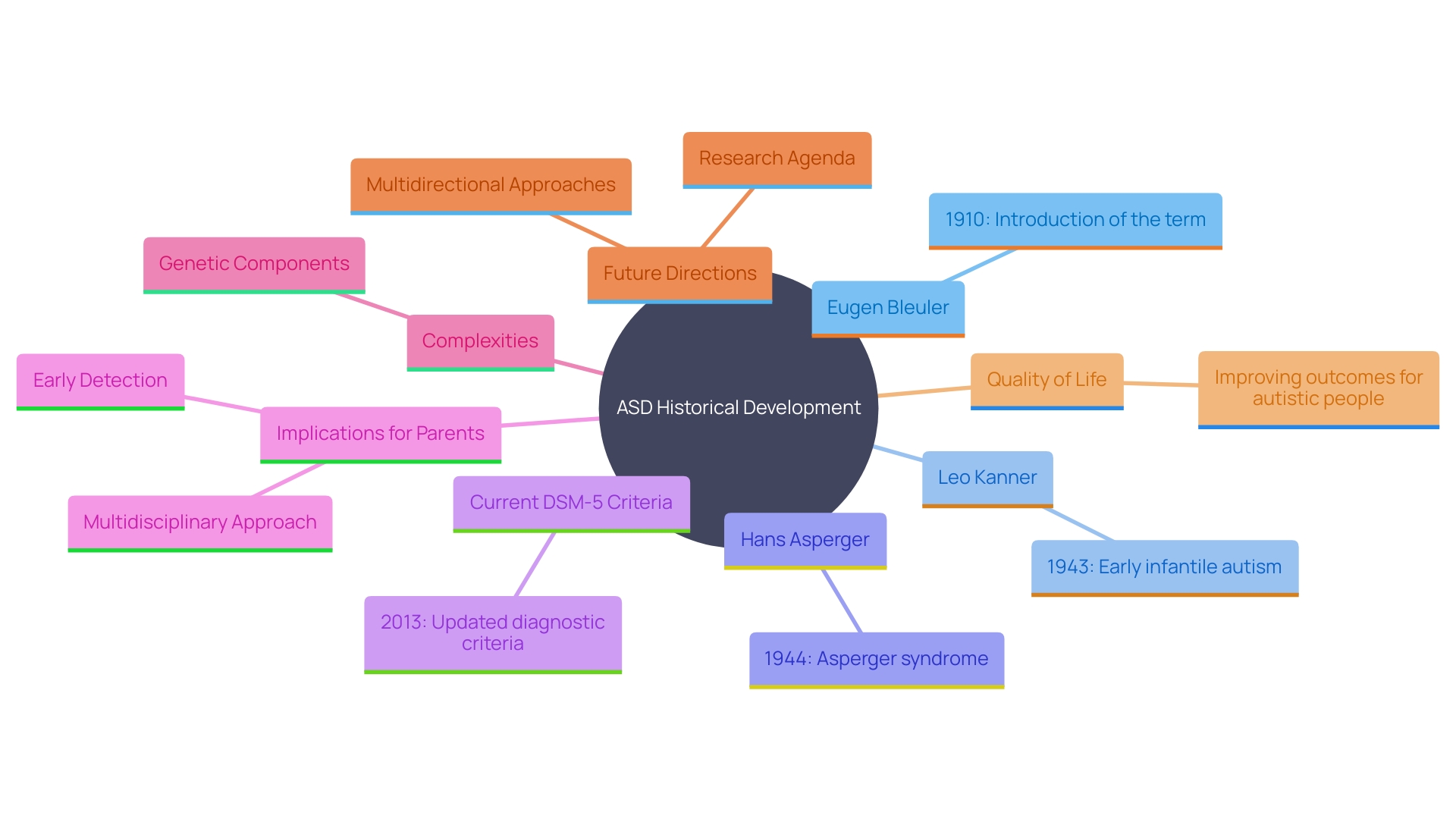
Practical Implications and Support Levels
Grasping the DSM-5 standards for developmental disorder is essential for caregivers to not only enable a precise assessment but also to guide successful assistance and support tactics. These criteria help parents recognize specific behavioral patterns and developmental characteristics, which are essential in seeking appropriate services and resources. For instance, prompt assistance initiatives aimed at communication can greatly enhance interactions between youngsters with developmental disorders and their guardians. Recent studies emphasize that developmental interventions designed for young individuals improve communication abilities, a fundamental challenge in autism.
Parents equipped with this knowledge can proactively address their offspring's unique needs and connect with resources that support their development. The complexity of Autism Spectrum Disorder (ASD) often requires a family's time, energy, and dedication. This can lead to significant parental stress, especially due to financial problems, anxiety about the child's future, and the absence of community support. However, evidence indicates that community and peer support can alleviate this distress, promoting emotional support, information exchange, and family well-being.
Additionally, recent progress in developmental disorder studies highlights the significance of early, suitable, and family-empowering approaches. These efforts aim to provide toddlers showing early signs of autism with better access to services that directly address communication challenges. Such actions are more effective when they include parental mediation, guiding parents in using techniques that promote social communication from a young age.
By staying informed about the DSM-5 criteria and the latest evidence-based interventions, parents can play a proactive and empowered role in their offspring's journey. This knowledge not only helps in managing the immediate needs of children with autism but also in planning for their long-term development and well-being.
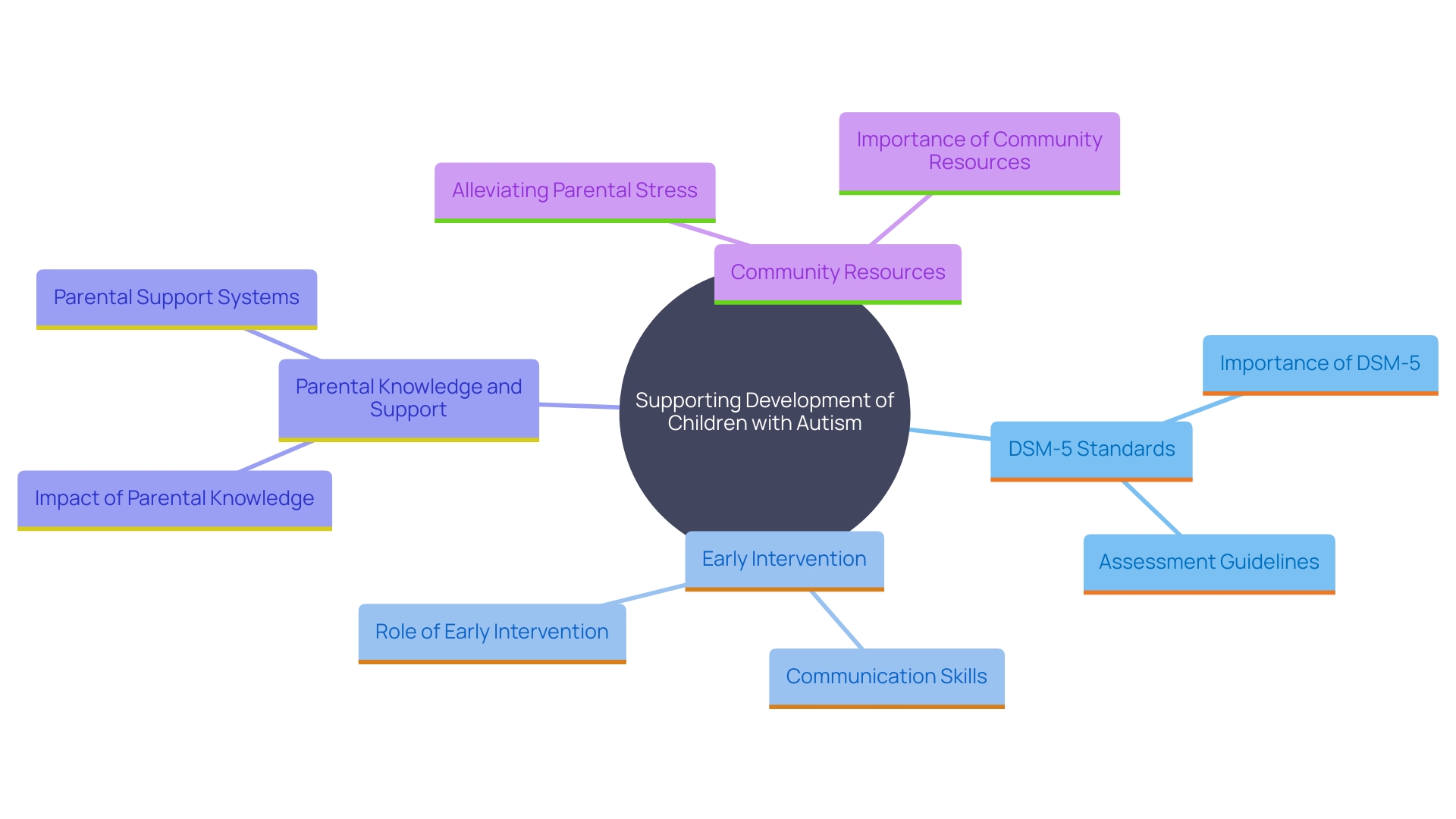
Conclusion
Navigating the complexities of autism spectrum disorder (ASD) requires a thorough understanding of the DSM-5 criteria. This framework provides a structured approach for diagnosing autism, highlighting crucial areas such as social communication deficits and restricted, repetitive behaviors. By recognizing these patterns early, parents and caregivers can advocate effectively for the necessary interventions and support their children need to thrive.
The severity levels outlined in the DSM-5 further emphasize the importance of tailored interventions. Understanding whether a child requires support, substantial support, or very substantial support allows families to seek appropriate resources that align with their child's unique challenges. This knowledge is vital in ensuring that children receive timely and effective care, ultimately improving their quality of life and social adaptation.
Early identification and intervention are critical in the journey of supporting a child with autism. Routine developmental screenings and proactive engagement with healthcare professionals can lead to significant improvements in social communication and overall development. Families equipped with knowledge about the DSM-5 criteria can navigate the landscape of autism support more confidently, fostering a nurturing environment that promotes their child’s growth and well-being.
By staying informed and engaged, parents can play a pivotal role in their child's journey, advocating for effective strategies that address individual needs. Empowering families with this knowledge not only enhances the immediate support available but also lays the groundwork for long-term success and fulfillment for children with autism.




